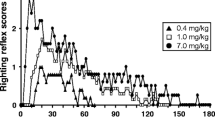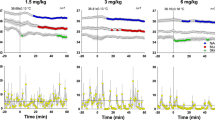Abstract
Intraperitoneal administration ofm-chlorophenylpiperazine (m-CPP) to Wistar rats produced hyperthermia with a peak effect at 30 min. Pretreatment with low doses of metergoline (5-HT1/5-HT2 antagonist), mesulergine and mianserin (5-HT2C/5-HT2A antagonists) blockedm-CPP-induced hyperthermia. Pretreatment with propranolol (β-adrenergic receptor antagonist that also has binding affinity for 5-HT1A, 5-HT1B and 5-HT2B sites), yohimbine (α2-noradrenergic antagonist that also has binding affinity for 5-HT2B sites), MDL-72222 or ondansetron (5-HT3 antagonists) did not attenuatem-CPP-induced hyperthermia. Only high doses of ketanserin, LY-53857 and ritanserin (5-HT2A/5-HT2C antagonists) as well as spiperone (5-HT1A/5-HT2A/D2 antagonist) attenuatedm-CPP-induced hyperthermia. Daily administration ofm-CPP produced complete tolerance to its hyperthermic effect by day 5. However, there was no cross-tolerance to 1-(2,5-dimethoxy-4-iodophenyl)-2-aminopropane (DOI, a 5-HT2A agonist that also has high affinity for 5-HT2C receptors)-induced hyperthermia.m-CPP-induced increases in temperature were found to be significantly less in the Fawn-Hooded (FH) rat strain as compared to the Wistar rat strain; in prior studies, FH rats have been found to be subsensitive to other 5-HT2C-mediated pharmacologic responses. Altogether, these findings suggest thatm-CPP-induced hyperthermia in rats is mediated by selective stimulation of 5-HT2C receptors.
Similar content being viewed by others
References
Aulakh CS, Wozniak KM, Hill JL, DeVane CL, Tolliver TJ, Murphy DL (1988) Differential neuroendocrine responses to the 5-HT agonistm-chlorophenylpiperazine in Fawn-Hooded rats relative to Wistar and Sprague-Dawley rats. Neuroendocrinology 48: 401–406
Aulakh CS, Hill JL, Murphy DL (1989) A comparison of feeding and locomotion responses to serotonin agonists in three rat strains. Pharmacol Biochem Behav 31: 567–571
Aulakh CS, Hill JL, Lesch KP, Murphy DL (1992a) Functional subsensitivity of 5-hydroxytryptamine1C or alpha2-adrenergic heteroreceptors mediating clonidine-induced growth hormone release in the Fawn-Hooded rat strain relative to the Wistar rat strain. J Pharmacol Exp Ther 262: 1038–1043
Aulakh CS, Hill JL, Murphy DL (1992b) Effects of various serotonin receptor subtype selective antagonists alone and onm-CPP-induced neuroendocrine changes in rats. J Pharmacol Exp Ther 263: 588–595
Aulakh CS, Mazzola-Pomietto P, Wozniak K, Hill J, Murphy DL (1994) Evidence that 1-(2,5-dimethoxy-4-methylphenyl)-2-aminopropane (DOM)-induced hypophagia and hyperthermia in rats is mediated by 5-HT2A receptors. J Pharmacol Exp Ther 270: 127–132
Berendsen HHG, Jenck F, Broekkamp CLE (1990) Involvement of 5-HT1C receptors in drug-induced penile erections in rats. Psychopharmacology 101: 57–61
Butler A, Hill JM, Ireland SJ, Jordan CC, Tyers MB (1988) Pharmacological properties of GR38032F, a novel antagonist at 5-HT3 receptors. Br J Pharmacol 94: 397–412
Caccia S, Ballabio M, Samanin R, Zanini MG, Garattini S (1981) (-)-m-Chlorophenyl-piperazine, a central 5-hydroxytryptamine agonist, is a metabolite of trazodone. J Pharm Pharmacol 33: 477–478
Callahan PM, Cunningham KA (1994) Involvement of 5-HT2C receptors in mediating the discriminative stimulus properties ofm-chlorophenylpiperazine (m-CPP). Eur J Pharmacol 257: 27–38
Conn PJ, Sanders-Bush E (1987) Relative efficacies of piperazines at the phosphoinositide hydrolysis-linked serotonergic (5-HT2 and 5-HT1C) receptors. J Pharmacol Exp Ther 242: 552–557
Costall B, Domeney AM, Naylor RJ, Tyers MB (1987) Effects of the 5-HT3 receptor antagonist, Gr38032F, on raised dopaminergic activity in the mesolimbic system of the rat and marmoset brain. Br J Pharmacol 92: 881–894
Fiorella D, Rabin RA, Winter JC (1995) The role of the 5-HT2A and 5-HT2C receptors in the stimulus effects ofm-chlorophenylpiperazine. Psychopharmacology 119: 222–230
Fozard JR (1984) MDL-72222, a potent and highly selective antagonist at neuronal 5-hydroxytryptamine receptors. Naunyn-Schmiedeberg's Arch Pharmacol 326: 36–44
Fuller RW (1990) Serotonin receptors and neuroendocrine responses. Neuropsychopharmacology 3: 495–502
Gudelsky GA, Koenig JI, Meltzer HY (1985) Altered responses to serotonergic agents in Fawn-Hooded rats. Pharmacol Biochem Behav 22: 489–492
Gudelsky GA, Koenig JI, Meltzer HY (1986) Thermoregulatory responses to serotonin (5-HT) receptor stimulation in the rat. Neuropharmacology 25: 1307–1313
Hoyer D (1988) Functional correlates of serotonin 5-HT1 recognition sites. J Recept Res 8: 59–81
Hoyer D, Schoeffter P (1991) 5-HT receptors: subtypes and second messengers. J Recept Res 11: 197–214
Hoyer D, Clarke DE, Fozard JR, Hartig PR, Martin GR, Mylecharane EJ, Saxena PR, Humphrey PPA (1994) International union of pharmacology classification of receptors for 5-hydroxytryptamine (serotonin). Pharmacol Rev 46: 157–203
Hulihan-Giblin BA, Park YD, Aulakh CS, Goldman D (1992) Regional analysis of 5-HT1A and 5-HT2 receptors in the Fawn-Hooded rat. Neuropharmacology 31: 1095–1099
Hulihan-Giblin BA, Park YD, Goldman D, Aulakh CS (1993) Analysis of the 5-HT1C receptor and the serotonin uptake site in Fawn-Hooded rat brain. Eur J Pharmacol 239: 99–102
Humphrey PPA, Hartig P, Hoyer D (1993) A proposed new nomenclature for 5-HT receptors. Trends Pharmacol Sci 14: 233–236
Kalkman HO, Fozard JR (1991) Serotonin: molecular biology, receptors and functional effects. Birkhauser, Basel
Kennett GA (1993) 5-HT1C receptors and their therapeutic relevance. Curr Opin Invest Drugs 2: 317–362
Kennett GA, Curzon G (1988) Evidence thatm-CPP may have behavioral effects mediated by central 5-HT1C receptors. Br J Pharmacol 94: 137–147
Kennett GA, Curzon G (1991) Potencies of antagonists indicate that 5-HT1C receptors mediate 1-3(chlorophenyl)piperazine-induced hypophagia. Br J Pharmacol 103: 2016–2020
Klodzinska A, Chojnacka-Wojcik E (1992) Hyperthermia induced bym-trifluoromethylphenylpiperazine (TFMPP) orm-chlorophenylpiperazine (m-CPP) in heat-adapted rats. Psychopharmacology 109: 466–472
Mazzola-Pomietto P, Aulakh CS, Wozniak KM, Hill JL, Murphy DL (1995) Evidence that 1-(2,5-di-methoxy-4-iodophenyl)-2-aminopropane (DOI)-induced hyperthermia in rats is mediated by stimulation of 5-HT2A receptors. Psychopharmacology 117: 193–199
Mueller EA, Murphy DL, Sunderland T (1985) Neuroendocrine effects ofm-chlorophenylpiperazine, a serotonin agonist, in humans. J Clin Endocrinol 61: 1179–1184
Murphy DL, Lesch KP, Aulakh CS, Pigott TA (1991) Serotonin-selective arylpiperazines with neuroendocrine, behavioral, temperature, and cardiovascular effects in humans. Pharmacol Rev 43: 527–552
Murphy DL, Mazzola-Pomietto P, Wozniak KM, Garrick NA, Hill JL, Aulakh CS (1993) Evidence that DOI-induced hyperthermia in rats is mediated by 5-HT2 receptors. Soc Neurosci Abstr 19: 1380
Nash JFJ, Meltzer HY, Gudelsky GA (1989) Selective cross-tolerance to 5-HT1A and 5-HT2 receptor-mediated temperature and corticosterone responses. Pharmacol Biochem Behav 33: 781–785
Pawlowski L (1984) Amitriptyline and femoxetine, but not clomipramine or citalopram, antagonize hyperthermia induced by directly acting 5-hydroxytryptamine-like drugs in heat adapted rats. J Pharm Pharmacol 36: 197–199
Pompeiano M, Palacios JM, Mengod G (1994) Distribution of the serotonin 5-HT2 receptor family mRNAs: comparison between 5-HT2A and 5-HT2C receptors. Mol Brain Res 23: 163–178
Pranzatelli MR (1990) Evidence for involvement of 5-HT2 and 5-HT1C receptors in the behavioral effects of the 5-HT agonist 1-(2,5-dimethoxy-4-iodophenyl)-2-aminopropane (DOI). Neurosci Lett 115: 74–80
Rauhala P, Idanpaan-Heikkila JJ, Lang A, Tuominen RK, Mannisto PT (1995) Cold exposure attenuates effects of secretagogues on serum prolactin and growth hormone levels in male rats. Am J Physiol 268: E758-E765
Richardson BP, Engel G, Donatsch P, Stadler PA (1985) Identification of serotonin M-receptor subtypes and their specific blockade by a new class of drugs. Nature 316: 126–131
Rittenhouse PA, Bakkum EA, Van de Kar LD (1991) Evidence that the serotonin agonist, DOI, increases renin secretion and blood pressure through both central and peripheral 5-HT2 receptors. J Pharmacol Exp Ther 259: 58–65
Schwartz PJ, Wehr TA, Rosenthal NE, Bartko JJ, Oren DA, Leutke C, Murphy DL (1995) Serotonin and thermoregulation: physiologic and pharmacologic aspects of control revealed by intravenousm-CPP in normal human subjects. Neuropsychopharmacology (in press)
Simansky KJ, Schechter LE (1988) Properties of somel-arylpiperazines as antagonists of stereotyped behaviors mediated by central serotonergic receptors in rodents. J Pharmacol Exp Ther 247: 1073–1081
Titeler M, Lyon RA, Glennon RA (1988) Radioligand binding evidence implicates the brain 5-HT2 receptor as a site of action for LSD and phenylisopropylamine hallucinogens. Psychopharmacology 94: 213–216
Tricklebank MD, Fowler C, Fozard JR (1985) The involvement of subtypes of the 5-HT1 receptor and of catecholaminergic systems in the behavioral response to 8-hydroxy-2-(di-n-propyl-amino)tetralin in the rat. Eur J Pharmacol 106: 271–282
Wang P, Aulakh CS, Hill JL, Murphy DL (1988) Fawn-Hooded rats are subsensitive to the food intake suppressant effects of 5-HT agonists. Psychopharmacology 94: 558–562
Wozniak KM, Aulakh CS, Hill JL, Murphy DL (1988) The effect of 8-OH-DPAT on temperature in the rat and its modification by chronic antidepressant treatments. Pharmacol Biochem Behav 30: 451–456
Wozniak KM, Aulakh CS, Hill JL, Murphy DL (1989) Hyperthermia induced bym-CPP in the rat and its modification by antidepressant treatments. Psychopharmacology 97: 269–274
Author information
Authors and Affiliations
Rights and permissions
About this article
Cite this article
Mazzola-Pomietto, P., Aulakh, C.S., Wozniak, K.M. et al. Evidence thatm-chlorophenylpiperazine-induced hyperthermia in rats is mediated by stimulation of 5-HT2C receptors. Psychopharmacology 123, 333–339 (1996). https://doi.org/10.1007/BF02246643
Received:
Revised:
Issue Date:
DOI: https://doi.org/10.1007/BF02246643




